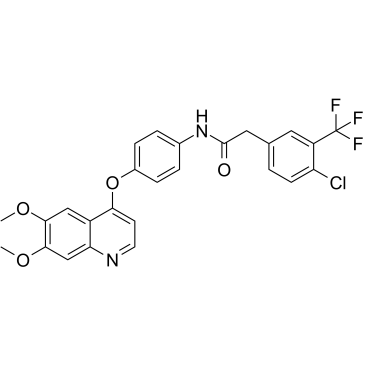| In Vitro |
c-Kit-IN-3 (Compound 18; 0.1-10 μM; 6 days; primary GIST patient cells) exhibits dose-dependent antiproliferative effects[1]. c-Kit-IN-3 (0.01-1 μM; 24 hours; GIST-T1, GIST-T1-T670I, and GIST-5R cells) treatment induces dose-dependent cell apoptotic death (by examining the cleaved PARP and cleaved caspase 3)[1]. c-Kit-IN-3 (0.01-1 μM; 24 hours; GIST-T1, GIST-T1-T670I, and GIST-5R cells) treatment arrests the cell cycle into the G0/G1 phase in all of these three cell lines[1]. c-Kit-IN-3 (0-1 μM; 24 hours) blocks the autophosphorylation of c-KIT pY703, pY719, and pY823 in GIST-T1, GIST-T1-T670I, and GIST-5R, respectively, cells at a concentration of 30 nM and inhibits the downstream signaling mediators pAKT (T308/S473), pS6 (S235/236), and pERK (T202/204)[1]. c-Kit-IN-3 potently inhibits the activity of CSF1R (IC50: 18 nM), PDGFRα (IC50: 25 nM), RET (IC50: 34 nM), and it relatively less potently inhibits DDR1 (IC50: 135 nM), FLT4 (IC50: 121 nM), and PDGFRβ (IC50: 97 nM)[1]. c-Kit-IN-3 (0.006 μM-1.37 μM) potently inhibits the growth of c-KIT-dependent GIST cancer cells, such as GIST-T1 (IC50: 0.006 μM); GIST-882 (IC50: 0.013 μM); GIST-T1-T670I (IC50: 0.011 μM); GIST-5R (IC50: 0.073 μM); GIST-48B (IC50: 1.37 μM), respectively[1]. Cell Proliferation Assay[1] Cell Line: Primary GIST patient cells Concentration: 0.1 μM, 0.3 μM, 1 μM, 3 μM, 10 μM Incubation Time: 6 days Result: Inhibition of the proliferation of primary GIST patient cells. Cell Cycle Analysis[1] Cell Line: GIST-T1, GIST-T1-T670I, and GIST-5R cells Concentration: 0.01 μM, 0.03 μM, 0.1 μM, 0.3 μM, 1 μM Incubation Time: 24 hours Result: Arrested the cell cycle into the G0/G1 phase in all of these three cell lines. Apoptosis Analysis[1] Cell Line: GIST-T1, GIST-T1-T670I, and GIST-5R cells Concentration: 0.01 μM, 0.03 μM, 0.1 μM, 0.3 μM, 1 μM Incubation Time: 24 hours Result: Induced dose-dependent cells apoptotic death. Western Blot Analysis[1] Cell Line: GIST-T1, GIST-T1-T670I, and GIST-5R cells Concentration: 0.01 μM, 0.03 μM, 0.1 μM, 0.3 μM, 1 μM Incubation Time: 24 hours Result: Decreased the autophosphorylation of c-KIT pY703, pY719, and pY823 in GIST-T1, GIST-T1-T670I, and GIST-5R cells, respectively.
|
